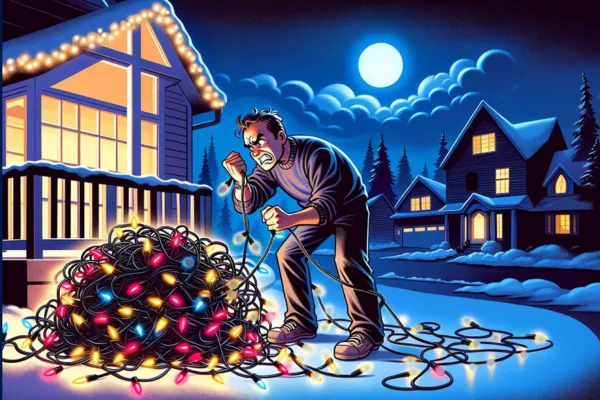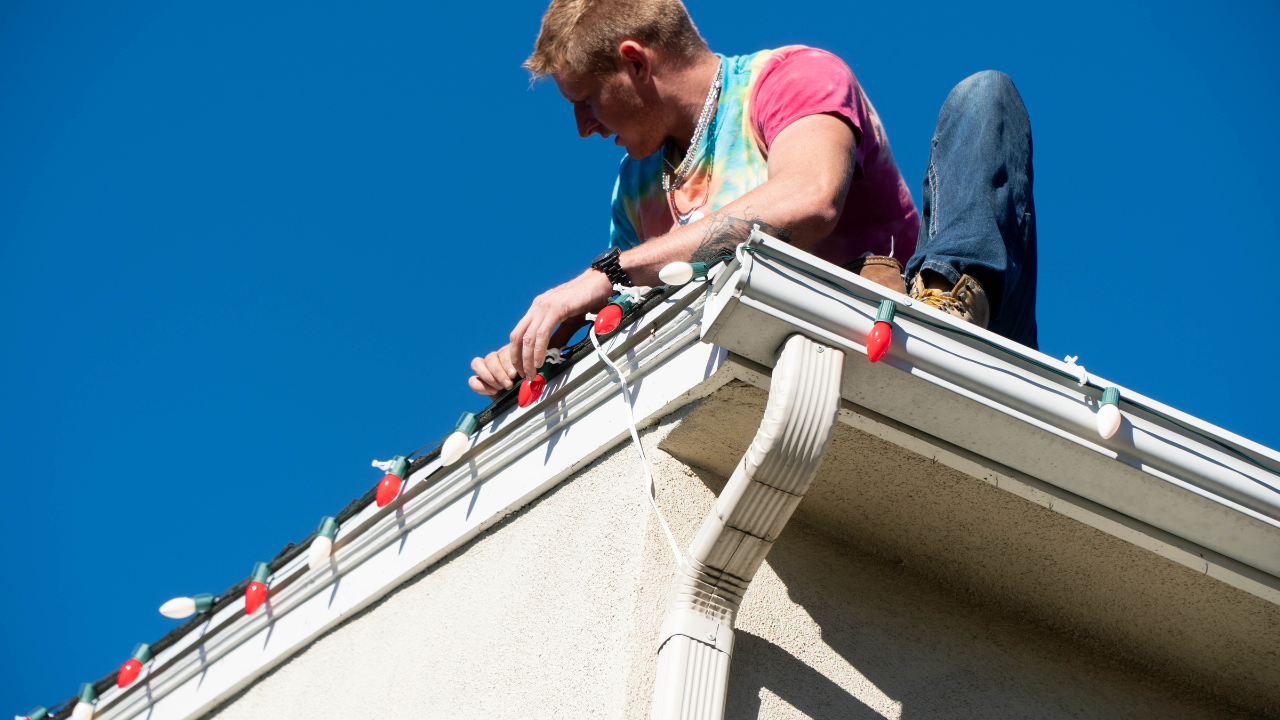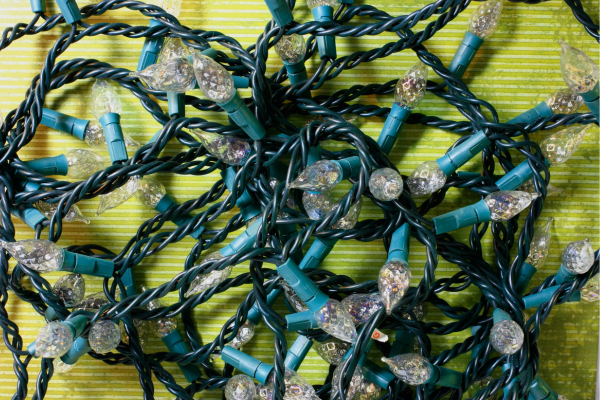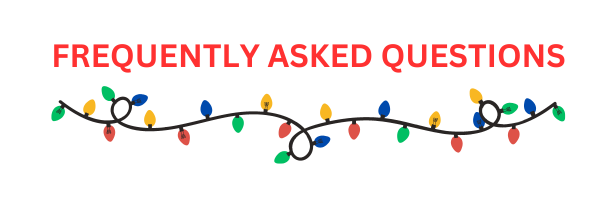Podcast

Why are Half My Christmas Lights Out?!
As the first snowflakes of the season weave their silent tapestry upon the ground, you're confronted with a half-dark strand of Christmas lights, a stark reminder of joy's fragility. You've meticulously untangled and arranged them, only to find that part of your work shines brightly, while the rest remains shrouded in darkness. This common predicament begs the question: why do these luminous strings betray us, leaving our festive spirit in the cold? While the answers are myriad, ranging from simple bulb failures to more complex electrical issues, uncovering the root cause is essential. Let's explore how to diagnose and remedy these half-lit frustrations, ensuring your holiday glow is never again dimmed by unforeseen shadows.

Common Malfunction Causes
Identifying the root cause of your Christmas lights not working often starts with checking for a bulb that's popped out of its socket or a broken wire. However, your detective work shouldn't stop there. You've also got to consider faulty connections, which are a common culprit. These can occur when wires become frayed or when plug contacts aren't properly aligned. You're dealing with electricity, after all, so even the slightest misstep can lead to a blackout.
Voltage fluctuations are another beast altogether. They can fry your lights faster than a turkey on Thanksgiving if you're not careful. This is especially true if you've got your entire home lit up like a runway. Similarly, never underestimate the havoc that weather damage can wreak on your outdoor lights. Moisture and cold can damage bulbs and wires alike, leading to frustrating outages.
Loose sockets and incorrect bulb sizes can also throw a wrench in your holiday cheer. If a bulb isn't snug in its socket, it won't light up, and using the wrong size can lead to an entire string going dark. So, before you call it quits, make sure you've checked these potential issues thoroughly.
Effective Solution Strategies
Once you've pinpointed the issue with your Christmas lights, it's time to tackle repairs head-on. Begin by conducting a thorough bulb inspection. Carefully examine each bulb for any signs of damage or displacement. If you spot a culprit, replace it immediately, as a single faulty bulb can affect an entire string.
Next, perform a connection check. Ensure that each bulb is securely seated in its socket. Loose connections are often to blame for lighting failures. While you're at it, glance over the wiring for any visible signs of wear or damage. If anything looks amiss, it might be time for a more extensive repair or replacement.
Don't overlook the importance of a fuse replacement. If your lights come with a voltage regulator, check to see if the fuse within has blown. Replacing a blown fuse can quickly bring your lights back to life. You'll typically find spare fuses included with your lights or available at a hardware store.
Lastly, engage in circuit testing. This step might require a bit more technical skill, but it's essential for identifying less obvious issues. Use a Kill A Watt meter to test the continuity of the light string. If the circuit isn't complete, there's likely a break that needs addressing.

Whole String Issues
After addressing individual bulb issues, it's crucial to examine problems affecting the entire string of Christmas lights. Sometimes, you're dealing with a circuit failure that stops the whole set from lighting up. This can often be resolved by checking for and replacing any blown fuses. Fuse replacement is a straightforward fix; just make sure you've got the right type and size for your light string.
But what if it's not the fuse? Wiring damage is another common culprit. This could be due to age-related issues, where wires become brittle and break, or it could be the result of animal damage. Squirrels, rabbits, and other critters have a knack for chewing through light strings, leaving you in the dark. In both cases, you might find sections—or the entire string—unresponsive.
Addressing these issues can be more complex. If it's wiring damage due to animals or wear and tear, inspect the cord closely for any visible signs of breakage. Unfortunately, if the damage is extensive, it might be time to consider replacing the whole set. Remember, safety first—don't attempt repairs on severely damaged wires yourself.
Maintenance and Prevention
To ensure your Christmas lights last for many seasons, it's crucial to adopt effective maintenance and prevention strategies. First off, let's talk about inspection techniques. You'll want to routinely inspect your lights for any visible signs of wear or damage. This includes looking for frayed wires, broken bulbs, and ensuring all bulbs are properly seated in their sockets.
Preventive measures are just as important. Always handle your lights gently to prevent damage and store them properly when not in use. This could mean wrapping them around a sturdy cardboard piece to avoid tangling and keeping them in a cool, dry place.
Safety precautions cannot be overstated. When installing your lights, ensure you're not overloading your circuits, which can be a fire hazard. Also, switch off your lights when you're not at home or while sleeping to reduce risks.
Maintenance tips include replacing any burnt-out bulbs promptly to prevent overloading the remaining bulbs, which can shorten their lifespan. Also, consider using LED lights, as they're more durable and energy-efficient.
Lastly, familiarize yourself with basic troubleshooting methods. While detailed troubleshooting will be covered later, knowing how to check and replace fuses can save you time and frustration.

Troubleshooting Techniques
Diving into troubleshooting techniques, you'll first want to grab a light tester to pinpoint the problem with your Christmas lights. This handy tool helps you easily detect any faulty bulbs that might be causing the whole string to go dark. But troubleshooting doesn't stop at just finding a dud bulb. Voltage fluctuations often play a sneaky role in disrupting your festive display. These fluctuations can overwork your lights, leading to premature burnout. It's crucial to ensure your lights are compatible with your home's voltage to avoid such issues.
Next, you'll want to tackle connection issues and faulty sockets, common culprits behind half-lit strings. Loose connections can stem from bulbs not being screwed in tightly or from wear and tear over the years. Give each bulb a gentle twist to ensure they're securely in place. Additionally, inspect sockets for signs of damage or corrosion that could interrupt the flow of electricity.
Weather-related problems and bulb compatibility are also important to consider. Outdoor lights are especially vulnerable to moisture and temperature changes, which can damage sockets and wiring. Ensure your lights are suitable for outdoor use and rated for the weather conditions in your area. Lastly, mixing different types of bulbs can lead to uneven loads and cause sections to go out. Stick with bulbs that are compatible with your light set to ensure consistent lighting throughout.

Can Weather Conditions, Like Rain or Snow, Affect the Functionality of Outdoor Christmas Lights?
Absolutely, weather conditions like rain or snow can impact your outdoor Christmas lights. It's critical to check their waterproof ratings before buying. Installation errors, such as not securely connecting lights, can lead to malfunctions. To shield your lights, take protective measures by choosing the right connector types and ensuring high light quality. This way, your lights stay bright and functional, regardless of the weather, keeping your holiday spirit undimmed.
How Do Variations in Voltage Supply Impact the Performance of Christmas Lights?
When you're dealing with variations in voltage supply, your Christmas lights might not perform as expected. Voltage spikes can lead to circuit overload, affecting both bulb quality and lifespan. If your lights are in series wiring, a spike can knock out an entire section. However, lights wired in parallel circuits might fare better, as only the affected bulb would go out. Always check for voltage consistency to prevent these issues.
Are There Specific Brands or Types of Christmas Lights That Are Known for Having Fewer Issues With Partial or Complete Outages?
You're likely wondering if some Christmas light brands or types are more reliable, with fewer outages. Look for lights known for their durability, brand reputation, and LED efficiency. These often have better color consistency and come with solid warranty offerings. LED lights, in particular, are less prone to issues and can save you a lot of headache. Always check brand reviews for reliability and customer satisfaction before making your purchase.
What Are the Environmental Impacts of Disposing of Non-Working Christmas Lights, and How Can I Recycle Them Responsibly?
When you toss out non-working Christmas lights, you're contributing to light pollution, adding to the e-waste challenge due to their material toxicity, and increasing energy consumption. It's crucial to recycle them responsibly. Look for recycling centers that accept e-waste. They'll handle the toxic materials safely and repurpose what they can. By doing so, you're not just cleaning up your space; you're also taking a step towards a more sustainable planet.
How Does the Age of My Home's Electrical Wiring System Affect the Safety and Functionality of Plugging in Multiple Strands of Christmas Lights?
If your home's electrical wiring is older, you might face issues plugging in multiple Christmas lights. Wiring compatibility can be a challenge, as outdated systems may not support the energy demands. You risk circuit overload, which can trip breakers or blow fuses. Moreover, older outlets might not meet current grounding requirements, reducing safety. Always check the fuse capacity before adding more lights to ensure your setup doesn't exceed your home's electrical capabilities.

So, you've tackled the half-lit dilemma head-on. Remember, most lighting woes stem from simple issues like loose bulbs or worn-out ones. Keep a keen eye on maintenance and don't overload your circuits. When in doubt, swapping out the old for new can save a heap of trouble. With these tips, you're now equipped to keep your Christmas lights shining bright, ensuring a fully festive glow that'll make your holiday season truly sparkle. Happy decorating!
Copyright ©2025 All Right Reserved website designed by christmaslights.io
Terms of Service / Privacy Policy
Have questions or need assistance?
Contact us at (855)619-LITE


